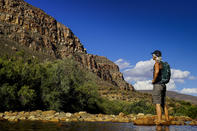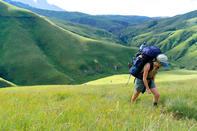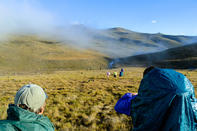Hiking in South Africa can be a bit daunting - the unreliable weather, access to water and challenging terrains can make it difficult to trek on an adventure.

Not to worry! There are basic essentials that every hiker must have, e.g. water bottles, comfortable clothing and plenty of sunscreen. Other than that, here is a quick guide that will make your outdoor walking experience all the more comfy and secure:
Whch Gear?

The gear required for a hike depends wholly on where, when and what you are planning. A day hike differs vastly from a multi-day trek in scope, for example, and so will your kit requirements. To simplify preparations, your gear and supplies may be divided into various key categories, and the following list will be a good starting point.
Pack: Select from a range of anything from tiny daypacks to 120l rucksacks, but make sure it is comfortable and can handle the load.
Clothing, footwear and headgear: Mix and match various clothing items, taking into account factors such as weather, route distance and terrain.
Shelter: You need to protect yourself from the elements, and you should always pack an emergency space blanket, even on those easy day hikes.
Utensils and Other: Everything from stoves and cooking gear to plates, a torch, map, guidebook, compass, camera and a survival kit.
First Aid & Toiletries: You can skimp on the latter, but make sure you are medically prepared if you head out into the African wilds.
Sleeping Material: The ratings of your sleeping bag and mattress will be determined by minimum temperatures expected on the route.
Food: You may have the best gear and clothing money can buy, but this will come to naught if you do not fuel your body with the right food and enough liquid.
Prepare for the Worst

A word of warning before you hike off into the wilderness: even the mildest of walks may morph into a wild and woolly outing if you do not prepare yourself for the many things that could go wrong. A good idea is to always walk with a companion or two, as this means someone can fetch help in case of injury or accident.
Your greatest dangers are not wild animals or rock falls, but rather sunburn, dehydration, hyperthermia (or overheating). Guard against UV rays and overheating by wearing a hat and breathable, protective clothing, and regularly apply sunscreen. Dressing in layers with a windproof outer shell will protect you against temperature fluctuations, wind and rain (always pack a shell, even if the weather seems mild).
Don’t wear new shoes on a long hike and pack a map, compass or GPS and a cell phone if you don’t know the route well. Carrying sufficient water is imperative, and play it safe by leaving an itinerary and estimated time of return with someone. Finally, the age-old cliché of ‘leaving nothing but footprints and taking nothing but pictures’ holds true to this day, so leave the trail the way you would like to find it.